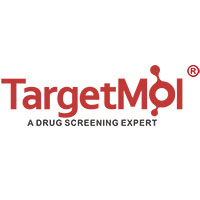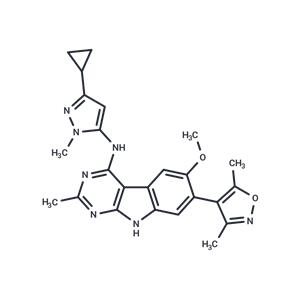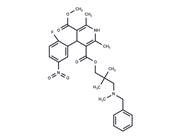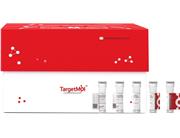| Name | CF53 |
| Description | CF53 is a highly potent, selective, and orally active inhibitor of BET protein, with a Ki of <1 nM, Kd of 2.2 nM, and an IC50 of 2 nM for BRD4 BD1. CF53 binds to both the BD1 and BD2 domains of BRD2, BRD3, BRD4, and BRDT BET proteins with high affinities, being very selective over non-BET bromodomain-containing proteins. CF53 exhibits potent anti-tumor activity both in vitro and in vivo. |
| In vitro | CF53 exhibits high binding affinities to the BD1 and BD2 domains of BRD2, BRD3, BRD4, and BRDT within the BET protein family, with dissociation constants (Kds) as follows: 1.1 nM for BRD2 BD1, 0.6 nM for BRD2 BD2, 0.52 nM for BRD3 BD1, 0.49 nM for BRD3 BD2, 0.8 nM for BRD4 BD2, 2 nM for BRDT BD1, and 2.1 nM for BRDT BD2. Additionally, it displays Kds of 47 nM, 570 nM, and 110 nM for CREBBP, CECR2, and EP300, respectively. In terms of biological activity, CF53 shows IC50 values of 7 nM and 85 nM against MOLM-13 acute leukemia and MDA-MB-231 breast cancer cell lines, respectively[1]. |
| In vivo | CF53, administered orally at doses of 25 and 50 mg/kg, demonstrates strong anti-tumor efficacy in both the MDA-MB-231 xenograft tumor model and the RS4;11 model in mice[1]. |
| Storage | Powder: -20°C for 3 years | In solvent: -80°C for 1 year | Shipping with blue ice. |
| Solubility Information | DMSO : 99 mg/mL (223.2 mM), Sonication is recommended.
|
| Keywords | CF-53 | CF53 | CF 53 |
| Inhibitors Related | Ribociclib | 3-methyl-1,2,3,4-tetrahydroquinazolin-2-one | (+)-JQ-1 | Curcumin | Palbociclib monohydrochloride | CASIN | Palbociclib | Naphthol AS-E | Sodium Oxamate | Abemaciclib | Dinaciclib | Abemaciclib methanesulfonate |
| Related Compound Libraries | Histone Modification Compound Library | Anti-Pancreatic Cancer Compound Library | Bioactive Compound Library | Epigenetics Compound Library | Kinase Inhibitor Library | Inhibitor Library | PPI Inhibitor Library | Orally Active Compound Library | Anti-Aging Compound Library | Bioactive Compounds Library Max | Anti-Cancer Compound Library | Anti-Cancer Active Compound Library |

 United States
United States



